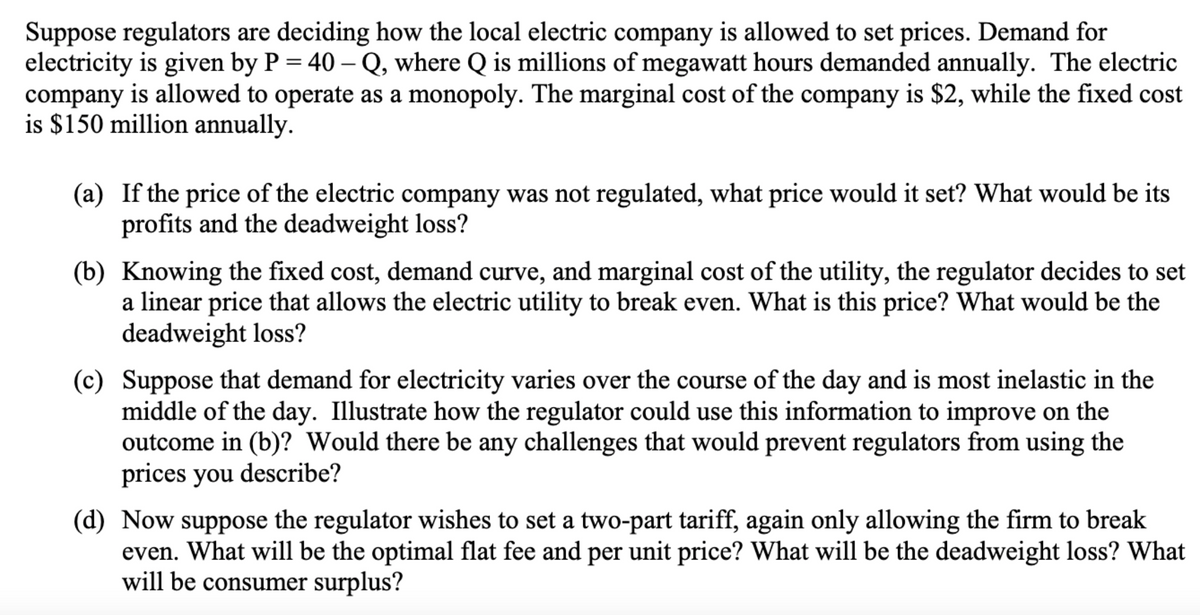Suppose regulators are deciding how the local electric company is allowed to set prices. Demand for electricity is given by P = 40-Q, where Q is millions of megawatt hours demanded annually. The electric company is allowed to operate as a monopoly. The marginal cost of the company is $2, while the fixed cost is $150 million annually. (a) If the price of the electric company was not regulated, what price would it set? What would be its profits and the deadweight loss? (b) Knowing the fixed cost, demand curve, and marginal cost of the utility, the regulator decides to set a linear price that allows the electric utility to break even. What is this price? What would be the deadweight loss? (c) Suppose that demand for electricity varies over the course of the day and is most inelastic in the middle of the day. Illustrate how the regulator could use this information to improve on the outcome in (b)? Would there be any challenges that would prevent regulators from using the prices you describe?
Suppose regulators are deciding how the local electric company is allowed to set prices. Demand for electricity is given by P = 40-Q, where Q is millions of megawatt hours demanded annually. The electric company is allowed to operate as a monopoly. The marginal cost of the company is $2, while the fixed cost is $150 million annually. (a) If the price of the electric company was not regulated, what price would it set? What would be its profits and the deadweight loss? (b) Knowing the fixed cost, demand curve, and marginal cost of the utility, the regulator decides to set a linear price that allows the electric utility to break even. What is this price? What would be the deadweight loss? (c) Suppose that demand for electricity varies over the course of the day and is most inelastic in the middle of the day. Illustrate how the regulator could use this information to improve on the outcome in (b)? Would there be any challenges that would prevent regulators from using the prices you describe?
Micro Economics For Today
10th Edition
ISBN:9781337613064
Author:Tucker, Irvin B.
Publisher:Tucker, Irvin B.
Chapter13: Antitrust And Regulation
Section: Chapter Questions
Problem 10SQP
Related questions
Question

Transcribed Image Text:Suppose regulators are deciding how the local electric company is allowed to set prices. Demand for
electricity is given by P = 40-Q, where Q is millions of megawatt hours demanded annually. The electric
company is allowed to operate as a monopoly. The marginal cost of the company is $2, while the fixed cost
is $150 million annually.
(a) If the price of the electric company was not regulated, what price would it set? What would be its
profits and the deadweight loss?
(b) Knowing the fixed cost, demand curve, and marginal cost of the utility, the regulator decides to set
a linear price that allows the electric utility to break even. What is this price? What would be the
deadweight loss?
(c) Suppose that demand for electricity varies over the course of the day and is most inelastic in the
middle of the day. Illustrate how the regulator could use this information to improve on the
outcome in (b)? Would there be any challenges that would prevent regulators from using the
prices you describe?
(d) Now suppose the regulator wishes to set a two-part tariff, again only allowing the firm to break
even. What will be the optimal flat fee and per unit price? What will be the deadweight loss? What
will be consumer surplus?
Expert Solution
This question has been solved!
Explore an expertly crafted, step-by-step solution for a thorough understanding of key concepts.
This is a popular solution!
Trending now
This is a popular solution!
Step by step
Solved in 4 steps

Knowledge Booster
Learn more about
Need a deep-dive on the concept behind this application? Look no further. Learn more about this topic, economics and related others by exploring similar questions and additional content below.Recommended textbooks for you







Managerial Economics: Applications, Strategies an…
Economics
ISBN:
9781305506381
Author:
James R. McGuigan, R. Charles Moyer, Frederick H.deB. Harris
Publisher:
Cengage Learning

Economics (MindTap Course List)
Economics
ISBN:
9781337617383
Author:
Roger A. Arnold
Publisher:
Cengage Learning
